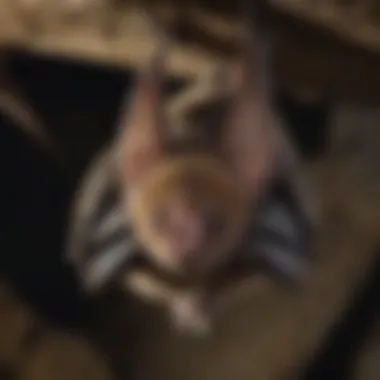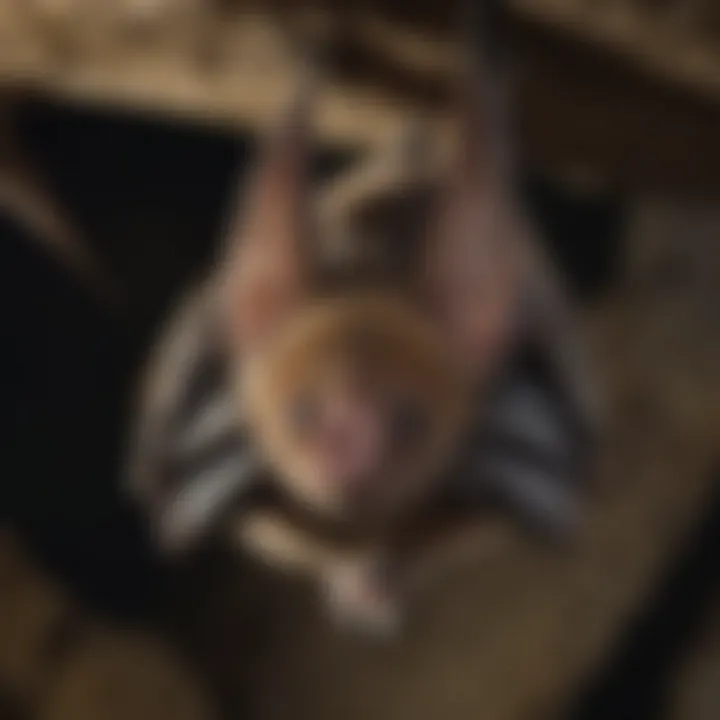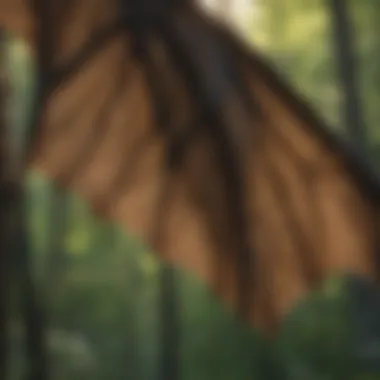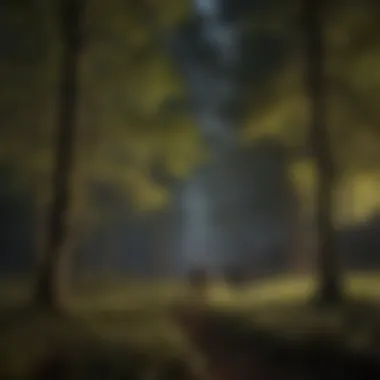Comprehensive Overview of Indiana Bat Facts


Intro
The Indiana bat (Myotis sodalis) is a fascinating yet endangered species that holds a significant place in North American woodland ecosystems. As environmental tensions rise, including habitat degradation and climate change, understanding this particular species becomes crucial. By investigating its biology, ecological roles, and conservation efforts, we can better appreciate the delicate balance of nature and the importance of biodiversity.
Understanding Woodland Ecosystems
Importance of Biodiversity in Forests
Biodiversity plays a critical role in maintaining healthy forests. It contributes to resilience, enabling ecosystems to recover from disturbances such as diseases or invasive species. The Indiana bat is a key component of this biodiversity. Its presence indicates a healthy environment where many species can thrive.
Forests rich in biodiversity offer numerous benefits, including:
- Habitat for Wildlife: Diverse plant species create varied habitats, which support a wide range of animals, including the Indiana bat.
- Ecosystem Services: Healthy forests provide air and water purification, soil stabilization, and carbon sequestration.
- Cultural and Recreational Value: Biodiverse areas enrich our experiences, offering spaces for recreation and connection with nature.
Role of Forests in Climate Regulation
Forests serve as vital carbon sinks, absorbing and storing carbon dioxide from the atmosphere. This process mitigates climate change affects by reducing greenhouse gas concentrations. The Indiana bat relies on these forested habitats for foraging and roosting, highlighting how its survival is linked to the health of forest ecosystems.
"Healthy forests are essential to balancing our planet’s climate. Without them, many species face extinction."
The interconnectedness of species and their habitats illustrates a broader ecological reality. Protecting the Indiana bat inherently supports other forest-dwelling organisms, further strengthening ecosystem integrity.
Sustainable Forestry Practices
Principles of Sustainable Forestry
Sustainable forestry aims to manage forest resources without compromising the health of ecosystems. This includes balancing ecological, economic, and social factors. Important principles include:
- Maintaining Biodiversity: Ensuring varied species continue to thrive, including the Indiana bat.
- Minimizing Environmental Impact: Reducing logging impacts on soil and water quality.
- Long-term Planning: Implementing forest management plans that focus on the future of the ecosystem.
Case Studies of Successful Implementations
Several regions have demonstrated successful sustainable forestry practices. These include managed reserves and protected areas that support both human needs and wildlife. For instance:
- Wayne National Forest: This area incorporates sustainable practices actively supporting Indiana bat populations.
- Daniel Boone National Forest: Conservation initiatives in this forest focus on preventing habitat loss for various species, including bats.
Woodland Stewardship Techniques
Forest Management Plans
Effective management plans are essential for preserving species like the Indiana bat. These plans often include strategies for habitat enhancement and minimizing human-wildlife conflict. Key components of these plans are:
- Monitoring Bat Populations: Regular assessments help understand population dynamics and threats.
- Habitat Restoration Efforts: Ensuring suitable roosting conditions and foraging opportunities.
Conservation Strategies
Multiple conservation strategies are in place to protect the Indiana bat. They include:
- Public Awareness Campaigns: Educating local communities about the importance of bats and their ecological roles.
- Regulatory Protection: Enforcing laws that minimize habitat destruction and protect known roosting sites.
The ongoing threats to the Indiana bat demand a multifaceted approach. Combining sustainable forestry practices, effective management plans, and community engagement forms a strong foundation for protecting this vital species.
Prolusion to the Indiana Bat
The Indiana bat (Myotis sodalis) is a small, nocturnal mammal that plays a crucial role in its ecosystem. Understanding this species is vital not just for ecological balance but also for biodiversity conservation efforts. The Indiana bat has seen a dramatic decline in numbers, becoming classified as an endangered species. Thus, the importance of its study extends beyond mere academic interest and into practical conservation needs.
Historially, the Indiana bat has been linked to various habitats across the eastern United States. Its specific needs and behaviors make it a species of particular focus for researchers and conservationists alike. The Indiana bat is known for its unique roosting habits and foraging patterns, which are essential for maintaining the ecological health of its environment.
During this article, we will delve into multiple aspects of the Indiana bat, including its background, scientific classification, physical traits, habitat preferences, and the pressing threats it faces today. This comprehensive overview provides an essential platform for forestry professionals and academics looking to understand this species's ecological significance. Avoiding clichés and superficial information, we aim to present well-researched content that contributes meaningfully to the discourse on conservation and the challenges presented by environmental change.
Historical Background
The Indiana bat was first identified in the early 19th century, which marked the beginning of its scientific recognition. Over the years, it has been observed that populations of this species began to dwindle significantly due to human-induced pressures. One prominent factor has been the loss of forested habitats where these bats roost, as they often use the same trees for generations.
During the mid-20th century, various investigations revealed alarming population trends. This continued decline has been accelerated by environmental disturbances such as logging and urban development. The Indiana bat has been protected since it was listed under the Endangered Species Act in 1967, yet efforts to conserve its populations face ongoing challenges.
Scientific Classification
The scientific community classifies the Indiana bat under the family Vespertilionidae, which encompasses a wide variety of bat species. Its classification is defined as follows:
- Kingdom: Animalia
- Phylum: Chordata
- Class: Mammalia
- Order: Chiroptera
- Family: Vespertilionidae
- Genus: Myotis
- Species: Myotis sodalis
Understanding the scientific classification of the Indiana bat provides a framework for studying its ecological role, physiological traits, and genetic diversity. As this species is closely related to other bats in its family, studying its genetic background offers insights into the evolution and adaptations of bats in general.
Physical Characteristics
Understanding the physical characteristics of the Indiana bat is essential for several reasons. First, these traits help in identifying the species and distinguishing it from other bat species. Second, knowledge of these attributes can give insight into their behavior, ecology, and the adaptations they have developed to thrive in their environment. Additionally, physical characteristics play a role in the conservation strategies being implemented to protect them. The following sections delve into two key aspects: size and weight, as well as coloration and markings.
Size and Weight
The size and weight of the Indiana bat can vary slightly across different populations, but on average, they are approximately 7 to 9 inches in total length. Their wingspan typically ranges between 9 to 10.5 inches, which is relatively modest compared to other bat species. When it comes to weight, Indiana bats usually weigh between 6 to 12 grams, making them lightweight creatures. This small size is beneficial as it allows for agility during flight, helping them to navigate through woodland areas effectively.
The compact form of Indiana bats is also an adaptation to their roosting preferences. Such physical characteristics enable them to fit into narrow crevices of trees or under loose bark, which are vital for their survival, especially during day times when they seek shelter. Knowing these size-related traits can aid in assessing habitat quality and understanding their seasonal behaviors.
Coloration and Markings


The coloration and markings of Indiana bats contribute to their ability to camouflage within their habitats. These bats exhibit a brownish-gray fur covering, which helps them blend into the tree bark or foliage, providing an advantageous concealment from predators. The key characteristic is the fur on their back, which is generally darker than that on their underside.
An important detail about their markings includes the presence of glossy fur that can appear somewhat iridescent under certain lighting. These subtle visual features might not only assist in camouflage but also play a role in social interactions among the bats. An added aspect is the paler facial features that differ from that of other bat species, providing a unique identification marker for researchers.
To summarize, the understanding of the Indiana bat’s physical characteristics is crucial for proper identification and the formulation of effective conservation practices. These attributes are not just details of appearance; they are vital components in the survival and thriving of the species in its natural habitat.
It's imperative to recognize how each characteristic plays a role in the ecological balance and conservation efforts surrounding this endangered species.
Habitat Preferences
Understanding the habitat preferences of the Indiana bat is crucial for conservation efforts and ecological balance. This species has specific needs that must be met to ensure successful roosting, foraging, and reproduction. Various factors such as temperature, humidity, and the availability of suitable roosting sites play a vital role in their life cycle. By examining these preferences, scientists and conservationists can create strategies to protect their habitats and support their populations.
Preferred Roosting Sites
Indiana bats require specific roosting sites for successful reproduction and survival. They typically roost in tree hollows or under loose bark of mature trees. The trees that provide these conditions are often located near water sources. These roosting sites help regulate their body temperature, as they prefer roosting in conditions with higher humidity levels. In addition, during the summer months, Indiana bats are often found in attics of buildings, abandoned structures, and occasionally in large rock crevices.
Effective conservation efforts must address the maintenance of these roosting habitats. Protecting mature forests is essential for this species, as younger trees do not provide adequate roosting options.
"The protection of roosting sites is a priority to secure the future of the Indiana bat, ensuring they have safe spaces for breeding and resting."
Foraging Habits
Foraging habits of the Indiana bat are tightly linked to their habitat. They primarily feed on night-flying insects such as moths and beetles. These bats forage in areas with abundant insect populations, which usually coincide with healthy forests and waterways. They employ echolocation to detect prey, flying at low levels to capture insects in-flight. Their foraging areas often include agricultural fields and forest edges.
An important aspect of conservation is to understand how the availability of food sources affects their populations. Changes in land use, pesticide application, and climate variations can all impact insect populations. To support the Indiana bat, efforts must be made to minimize these threats while promoting natural habitats where their food sources thrive.
Reproductive Behavior
Reproductive behavior is crucial for the survival and continuity of the Indiana bat populations. Understanding this aspect provides insights into their ecology and informs conservation strategies. Successful reproduction ensures the genetic diversity and resilience of the species, which is paramount given their endangered status.
Mating Season and Breeding
The mating season for Indiana bats typically occurs in late summer to early autumn, around August to September. During this time, male bats engage in competitive displays to attract females. They use vocalizations and aerial acrobatics, demonstrating their fitness as potential mates.
After mating, the female Indiana bats enter a phase of gestation lasting about 50 to 60 days. This period is critical; the female must find suitable roosting sites that offer warmth and protection. Research indicates that females often select tree cavities or buildings, which provide high temperatures essential for developing embryos.
The choice of roosting site is influenced by several factors, including the availability of resources and environmental conditions. In some instances, females will cluster together in maternity colonies, facilitating warmth and safety through social interactions.
Pup Development
Once the pups are born, usually in late June, they are wholly dependent on their mothers for sustenance and protection. Female Indiana bats nurse their young, providing vital nutrients necessary for growth. During the first weeks after birth, pups grow rapidly. They are born hairless and blind but gain fur and the ability to see within a few days.
After a few weeks, around three to four weeks old, pups begin to move out of the roost with their mothers, learning to fly and hunt for food. This stage of development is critical, as it teaches them the skills needed for survival. The mothers usually keep their pups close, ensuring they receive adequate care and support. A successful rearing of pups significantly contributes to population renewal and is vital for the species' long-term survival.
"The nurturing process of the Indiana bat emphasizes the mother’s vital role in ensuring the next generation thrives within a declining habitat."
The nuances of reproductive behavior, from mating rituals to pup development, underscore the resilience and adaptability of Indiana bats. Protecting these phases of their life cycle is imperative in preserving the species for future generations.
Dietary Needs and Feeding Patterns
The dietary needs and feeding patterns of the Indiana bat are central to understanding its ecological role and conservation. This section delves into the specific elements that characterize the bat's diet, the benefits derived from its unique feeding habits, and the overall considerations that impact its survival.
Primary Food Sources
Indiana bats primarily consume insects, which are vital to their survival. Their diet mainly consists of
- Moth species
- Beetles
- Flying ants
- Midges
These insects provide essential nutrients, allowing the bats to maintain energy levels necessary for their nocturnal activities. Indiana bats typically feed on insects that are abundant in their foraging areas, especially in forested regions or near water bodies where insects are plentiful. Their foraging behavior often peaks during warm nights when insect activity is higher, aligning their hunting patterns with the natural rhythms of their prey. This relationship underlines the bond between the Indiana bat and its ecological habitat.
Feeding Techniques
The feeding techniques employed by Indiana bats are quite specialized. They primarily utilize a method called aerial hawking, where they capture prey while in flight. This technique involves several key strategies:
- Echolocation: Indiana bats use echolocation to locate their insect prey. They emit ultrasonic calls that bounce off objects, helping them navigate and find food in the darkness.
- Flight Patterns: Their flight is agile and swift. Indiana bats often make sharp turns and exhibit rapid changes in elevation to intercept insects mid-air.
- Social Feeding: In some cases, Indiana bats may exhibit social feeding behavior, where multiple individuals forage in the same area. This can increase their foraging efficiency and help in locating concentrations of insects.
Overall, the dietary needs and feeding patterns of Indiana bats play a crucial role in maintaining healthy ecosystems by controlling insect populations.
"Maintaining insect population control is critical for the stability of forest ecosystems, where Indiana bats play an important part."
The ability of Indiana bats to adapt their feeding techniques according to the availability of food sources shows their ecological flexibility, reinforcing their significance within their ecosystem.
Behavioral Traits
Understanding the behavioral traits of the Indiana bat is essential for numerous reasons. These traits not only inform conservation strategies but also enhance the knowledge about its role in the ecosystem. The Indiana bat exhibits unique social structures and nocturnal patterns that are vital to its survival and reproduction. By studying these behaviors, researchers can determine effective measures to protect this endangered species and ensure their habitats are maintained.
Social Structure
The social structure of Indiana bats is primarily based around colonies. These colonies can vary in size, with some containing only a few dozen bats while others can include hundreds. Typically, these bats demonstrate a females-first social hierarchy during the breeding season. Males usually do not remain in roosts after breeding. The females form maternity colonies where they give birth and care for their young.
Social interactions among Indiana bats influence several aspects of their behavior. For example, young bats often learn foraging techniques from older bats within the colony. This communal learning is crucial since foraging efficacy directly impacts the overall health of the population. Moreover, a cohesive social unit helps protect the young against predators and increases the chances of survival during critical life stages.
Nocturnal Patterns
Indiana bats are primarily nocturnal, which is a significant behavioral trait that affects their feeding and mating habits. As dusk falls, these bats leave their roosts to begin foraging for insects. Their activity typically peaks during the first few hours of night, aligning with the cycles of their primary food sources, such as moths and other flying insects.
This nocturnal behavior is not arbitrary; it provides several advantages. For one, it allows them to exploit a food niche that many diurnal predators cannot. Moreover, breeding often occurs in the evening hours, as males call out to attract females, further emphasizing the importance of their nighttime activity.


A comprehensive understanding of these nocturnal patterns can lead to better conservation strategies. By knowing when and where Indiana bats are most active, conservationists can implement measures to minimize human interference during these critical periods.
"The behavioral traits of the Indiana bat play a crucial role in its ability to adapt and survive in changing environments, necessitating focused conservation efforts."
Conservation Status
The conservation status of the Indiana bat is critical. This species, scientifically known as Myotis sodalis, faces various risks that threaten its survival. Understanding its conservation status is essential for implementing effective measures to protect the species. Factors affecting its abundance and distribution are closely tied to environmental policies, habitat conservation, and urban development. The urgency of protecting the Indiana bat cannot be overstated, as it plays a vital role in the ecosystem.
Endangered Species Designation
The Indiana bat is listed as an endangered species. This classification is significant for several reasons. Firstly, it elevates the species' visibility in conservation discussions, prompting federal and state governments to implement specific measures for its protection. The Endangered Species Act provides legal backing, ensuring that suitable habitats are preserved. It also restricts activities that could harm Indiana bats or degrade their habitats.
The reasons behind this designation include declining populations attributed to habitat destruction, climate change, and disease. A notable disease affecting bat populations is white-nose syndrome, which has severely impacted many species across North America. The designation as endangered highlights the urgent need for targeted conservation strategies.
Population Trends
Population trends for the Indiana bat reveal a complex narrative. Initially, the species experienced a significant decline due to various pressures. Monitoring data shows that their numbers fluctuated, often reflecting the health of specific habitats where they roost. As of the latest surveys, there is a slight indication of population stabilization; however, numbers remain low compared to historical levels.
Long-term studies have indicated that certain populations are experiencing slight increases due to conservation efforts. For example, the protection of roosting and foraging areas has shown promising results. Nevertheless, ongoing threats such as habitat fragmentation and environmental changes still pose serious risks.
"Without dedicated conservation measures, the future of the Indiana bat species is uncertain. Their survival is intertwined with healthy ecosystems that support their needs."
In summary, the conservation status of the Indiana bat highlights both the challenges and opportunities for its recovery. Continued research and monitoring are essential to track population trends and inform future conservation policies.
Threats to the Indiana Bat
The Indiana bat is facing numerous threats that jeopardize its survival. Understanding these threats is essential, especially as they impact both the population and the habitat of this endangered species. Here, we will delve into three major threats: habitat loss and fragmentation, disease, and climate change. Each of these factors plays a critical role in shaping the future of Indiana bats and warrants careful consideration.
Habitat Loss and Fragmentation
Habitat loss is a prominent threat to the Indiana bat. They typically roost in dead or dying trees, particularly during the summer months when they are rearing pups. However, urban development, logging, and agriculture have led to a significant reduction in suitable roosting sites. According to various studies, over 80% of their habitat has been altered or lost in key areas. This loss not only reduces the available roosting locations but also fragments the remaining habitat, isolating bat populations and making it difficult for them to find mates.
Fragmentation can create barriers to their movement, limiting their access to food resources and mates. As forested areas are converted to agricultural land or urban developments, these bats are forced into smaller sections of habitat, which can increase competition for food and lead to genetic isolation.
Disease Impact
In recent years, diseases have emerged as a critical threat to the Indiana bat population. White-nose syndrome, a fungal infection, affects bats during their hibernation period. This disease causes bats to wake up during the winter, resulting in exhaustion and starvation as they utilize their fat reserves more quickly than normal. Research indicates that this disease has led to drastic declines in bat populations in infected areas.
The spread of white-nose syndrome has raised alarms among wildlife conservationists. Estimates suggest that as much as 90% of some local Indiana bat populations have vanished due to this disease. The impact is not just on the bats themselves but also on the overall health of the ecosystems they inhabit, as fewer bats mean less natural pest control.
Climate Change Factors
Climate change presents a multifaceted threat to the Indiana bat. As temperatures rise, changes in hibernation patterns, food availability, and migration routes can occur. Warmer winters may lead to earlier emergence from hibernation, which can result in bats being active before food sources become plentiful. This leads to increased vulnerability as bats may starve before insects become abundant in the spring.
Moreover, climate change can alter the habitats that Indiana bats rely on. Increased frequency and severity of storms can decrease the availability of suitable roosting sites. Changes in precipitation patterns may affect the insects that comprise the bats’ diet, thus impacting their foraging success. All these factors combined exacerbate the already precarious situation faced by Indiana bats.
"Understanding the specific threats to the Indiana bat is vital for implementing effective conservation strategies. Each factor interplays with the others, creating a complex web of challenges."
In summary, the threats to the Indiana bat, including habitat loss, disease, and the looming effects of climate change, underscore the urgent need for targeted conservation strategies. Addressing these issues is critical not only for the survival of the species but also for maintaining ecological balance.
Conservation Efforts
Conservation efforts play a critical role in ensuring the survival of the Indiana bat. This species faces numerous challenges, such as habitat loss and environmental changes due to human activity. Implementing effective conservation strategies is necessary to protect Indiana bats and their habitats. The primary goal of these efforts is to stabilize and increase the population of this endangered species. Furthermore, sound conservation actions benefit entire ecosystems, as Indiana bats play an essential role in insect control and pollination.
Federal and State Protection Laws
The legal framework surrounding the Indiana bat is pivotal in its conservation. Federal laws, such as the Endangered Species Act, classify the Indiana bat as an endangered species. This classification allows for the enforcement of strict regulations aimed at protecting critical habitats and minimizing the impact of human activities. Additionally, specific states have enacted their own legislation to enhance protections for Indiana bats. These laws may include restrictions on logging, mining, and land development within known bat habitats, contributing to the overall safety of these species.
Research and Monitoring Initiatives
Scientific research is vital in the conservation of Indiana bats. Various research and monitoring initiatives strive to understand the behaviors, populations, and health of these bats in greater detail. Ongoing population surveys provide crucial data on their numbers and distribution. This data can identify trends over time and help assess the effectiveness of current conservation strategies. Moreover, studies focused on the spread of diseases impacting Indiana bats contribute to a deeper understanding of the threats they face. Research findings inform policymakers and conservationists on necessary adjustments in strategies to ensure the ongoing survival of this challenged species.
Community Involvement
Community involvement is essential for the success of conservation efforts. Engaging with local communities fosters awareness and encourages action towards protecting Indiana bats. People at the grassroots level can participate in habitat restoration projects, educational programs, and citizen science initiatives. For instance, volunteering in bat habitat clean-up efforts or monitoring local populations can help create a sense of ownership over the preservation of this species. Collaboration between scientists, government agencies, and community members builds a solid support system for ongoing conservation efforts, amplifying the impact of any initiatives.
"To protect the Indiana bat, we must combine our legal, scientific, and community efforts into one cohesive approach."
Prioritizing these conservation efforts ensures that the Indiana bat continues to thrive within its natural environment. With clear legal protections, ongoing research, and strong community engagement, there is hope for a brighter future for this critical species.
Role of Indiana Bats in Ecosystems
The Indiana bat plays a crucial role in maintaining ecological balance within its habitat. Understanding this role helps highlight the necessity of conservation efforts aimed at protecting these bats. Their presence influences both plant and animal populations, elucidating their value beyond simply being an endangered species.
Pollination Contributions
Indiana bats, while primarily insectivorous, do play a part in pollination indirectly. As they forage, these bats visit a variety of flowering plants. Even though they are not the primary pollinators, their movement through different habitats can assist in the transfer of pollen among flowering species. This activity supports biodiversity as well as the health of many plants crucial for forest ecosystems. Research indicates that healthy bat populations can enhance the reproductive success of several plant species. Therefore, preserving Indiana bats indirectly benefits the overall plant community, which many other species rely on for survival.
Insect Population Control
One of the most significant contributions of the Indiana bat to its ecosystem is its ability to control insect populations. With a diet primarily consisting of moths and beetles, Indiana bats help regulate these insect numbers, preventing potential outbreaks that could harm crops and forests.
- Diet Composition: Indiana bats primarily consume insects such as moths, beetles, and flies. This varied diet indicates flexibility and adaptability in their feeding strategies.
- Impact on Agriculture: By controlling insect pests, these bats reduce the need for chemical pesticides. This naturally promotes healthier farming practices and supports sustainable crop production.
It is estimated that a single bat can consume thousands of insects in one night, showcasing their effectiveness in pest control.
Research Studies and Findings


Research studies on the Indiana bat are essential to understand its behavior, genetics, and conservation needs. This body of work is critical not only for the species itself but also for the ecosystems where these bats play a significant role. By examining the findings from various studies, we can gain insights on how to manage and protect their populations effectively. These research efforts contribute to creating a baseline for monitoring the health of the species and its habitat.
Behavioural Research
Behavioural research focuses on how Indiana bats interact within their environment. This includes studying their foraging habits and social interactions. One of the key findings is that Indiana bats exhibit specific roosting preferences that are crucial during breeding and hibernation. Understanding these preferences helps in habitat conservation.
Moreover, researchers have observed that these bats exhibit social structures that can influence their reproductive success. For example, forms of social behavior can affect the dynamics of mating and resource sharing.
Key aspects of behavioural research include:
- Foraging Behavior: Understanding what and how they feed can help in identifying critical feeding habitats and resources.
- Social Interactions: Observing how bats communicate and form groups can reveal insights into their social structure, impacting conservation strategies.
Most of studies use radio telemetry to track movements and behaviors in the wild. This can also help in identifying seasonal changes in their activity patterns. Such insights are valuable for developing conservation practices tailored to their needs.
Genetic Studies
Genetic studies are revealing more about the Indiana bat's population structure, genetic diversity, and resilience to disease. These factors play a significant role in assessing the long-term survival of the species. Understanding genetic variation among populations can indicate how they might respond to environmental pressures, such as climate change and habitat loss.
Some significant points from genetic research include:
- Genetic Diversity: High genetic diversity within a population usually correlates with better adaptability to changing environmental conditions.
- Disease Resistance: Studies have shown specific genetic markers associated with resistance to diseases affecting bats, like white-nose syndrome.
Genetic mapping technologies, such as DNA sequencing, are increasingly used to gather more precise data regarding the genetic variations of the Indiana bat. Insights obtained from these studies can guide conservation efforts and help in managing genetic health within bat populations.
"Understanding the behavioral patterns and genetic makeup of the Indiana bat provides vital insights for their conservation and management."
Public Policies Impacting Indiana Bats
The conservation of the Indiana bat is influenced significantly by public policies. These policies are designed to create an environment where the species can thrive despite various challenges. Understanding how these policies function can elucidate the resources and protections afforded to this endangered species.
Legislation and regulations act as the backbone of efforts to manage and protect the Indiana bat. They dictate how land use, conservation funding, and species management occur, ensuring that both development and environmental stewardship can coexist without detriment to the species.
Key elements of these policies include habitat protection, restoration initiatives, and initiatives to combat emerging threats such as diseases. Effective public policies aim to provide a framework for the cooperation between conservationists, policymakers, and landowners, all vital to the long-term survival of the Indiana bat.
Legislative Frameworks
Multiple laws govern the protection of the Indiana bat. The Endangered Species Act is among the most critical, providing federal protections to threatened and endangered species throughout the United States. This Act lays the groundwork for the recovery of the Indiana bat through regulatory measures that limit habitat destruction and promote conservation efforts.
In addition to federal laws, state-level legislation incorporates local considerations into conservation strategies. For instance, state wildlife agencies often develop management plans that align with broader federal guidelines while addressing specific regional challenges. Such policies may include
- Land-use planning
- Wildlife corridors creation
- Research funding opportunities
- Public land management practices
It is crucial for these legislative frameworks to evolve over time, adapting to new findings and the current status of the population. Collaboration with various sectors enhances the effectiveness and reach of these laws.
Environmental Regulations
Environmental regulations impact Indiana bats by governing land-use practices and habitat alterations. Comprehensive assessments are required before any significant development projects can start, ensuring that potential impacts on the Indiana bat’s habitat are evaluated and mitigated.
Moreover, various regulatory bodies require environmental impact statements or assessments. These are designed to predict how proposed projects might affect local ecosystems, including the habitats vital for the Indiana bat. Regulations may cover aspects such as
- Water quality standards
- Pesticide usage limitations
- Tree harvesting protocols
- Erosion controls
"Effective environmental regulations are essential for maintaining the ecological balance necessary for the survival of the Indiana bat."
By enforcing these regulations, authorities can help preserve essential habitats, contributing to the sustainability of the Indiana bat populations. While public policies do not directly protect bats, they create a structural framework that facilitates conservation efforts. Understanding these policies enhances the ability to protect the Indiana bat in a meaningful way.
Future Outlook for Indiana Bats
The future outlook for Indiana bats is a critical aspect of understanding their role in the ecosystem and the ongoing challenges they face. Given their endangered status and the ongoing threats they encounter, it is imperative to evaluate their projected population trends and the long-term conservation strategies that can ensure their preservation. This section emphasizes the necessity of proactive measures and policies to mitigate risks and promote a sustainable future for Indiana bats.
Projected Population Trends
Research indicates that the population of Indiana bats has experienced significant fluctuation over recent decades. There have been periods of decline followed by slight recoveries, yet the overall trend remains concerning. According to recent studies, the population is currently estimated to be around 500,000 individuals, which reflects a modest increase from previous estimates; however, this figure is stark compared to historical numbers.
Factors contributing to population dynamics include:
- Habitat loss: Urban development and land conversion disrupt critical roosting and foraging habitats.
- Disease impact: White-nose syndrome, a fungal disease, has led to mass mortality events in bat colonies.
- Climate change: Alterations in temperature and precipitation patterns can affect insect availability, which is crucial for feeding.
Projections for future populations are heavily dependent on the success of ongoing conservation efforts. If current threats are not mitigated, populations may continue to decline, posing further risks to the species. Conversely, effective blanket measures for habitat protection and disease management could lead to stabilization or growth in population numbers.
Long-term Conservation Strategies
For Indiana bats to thrive, long-term conservation strategies must be effective and adaptable. The following key strategies are essential:
- Habitat Restoration: Restoring and maintaining suitable habitats is vital. This involves preserving forests, wetlands, and other critical ecosystems essential for roosting, breeding, and foraging.
- Disease Management: Continuous monitoring for diseases, particularly white-nose syndrome, is necessary. Implementing control measures and research into treatments for affected bats can improve survival rates.
- Public Awareness and Education: Educating the public and raising awareness about the significance of Indiana bats is crucial. Increasing community involvement can lead to better outcomes for conservation initiatives.
- Collaboration Among Stakeholders: Cooperation among governmental bodies, conservation organizations, and local communities can facilitate more effective conservation plans. Ensuring all parties are aligned can optimize resource allocation and strategy implementation.
To truly safeguard the future of Indiana bats, a multifaceted approach that combines research, policy, and community engagement is necessary.
End
The conclusion of this article serves to underline the significant role that the Indiana bat plays within its ecosystem and emphasizes the urgent necessity for sustained conservation efforts. As a species that is currently classified as endangered, the Indiana bat's survival is contingent upon effective management strategies and public awareness. This section will synthesize the critical insights discussed throughout the article, serving as a reminder of the interconnectedness of biodiversity and the importance of bats in maintaining ecological balance.
Key Takeaways
- Vulnerability: The Indiana bat is at risk due to habitat loss, diseases, and changing climate conditions. Addressing these threats is crucial for its survival.
- Ecosystem Role: As insectivores, Indiana bats contribute significantly to controlling insect populations, which benefits agricultural practices and human health.
- Conservation Measures: Collaborative efforts among federal, state, and community stakeholders are essential for protecting this species and ensuring its habitat is preserved.
Call to Action for Conservation
To ensure the future of the Indiana bat, it is imperative for individuals and organizations to engage in conservation activities. Here are some actionable steps:
- Advocacy: Support policies and legislation aimed at protecting bat habitats. Engage with local representatives to promote bat-friendly practices.
- Education: Increase public knowledge about the importance of bats in ecosystems. Organize community workshops to share information and best practices.
- Participation: Join volunteer programs dedicated to monitoring bat populations and restoring habitats. Each contribution aids in strengthening conservation efforts.
Conservation of the Indiana bat is not merely an environmental concern; it is a commitment to the health of our ecosystems that benefits us all.







